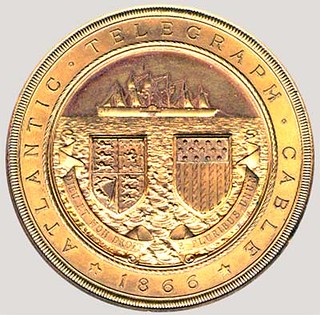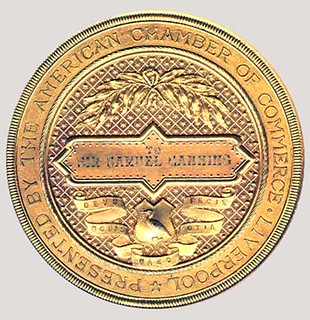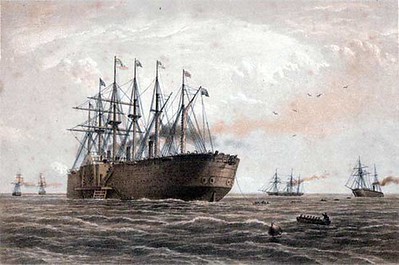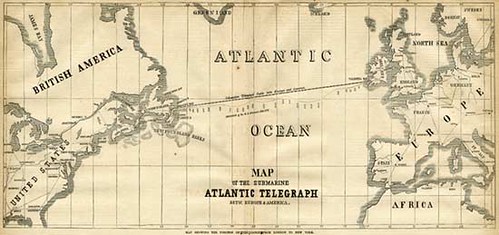
PREV ARTICLE
NEXT ARTICLE
FULL ISSUE
PREV FULL ISSUE
THE ATLANTIC CABLE MEDAL OF 1866Last week we briefly discussed an 1866 Atlantic Telegraph Cable Medal. Herman Blanton wrote about these in the July 2006 issue of The Numismatist, and there is also a version of his research on the Atlantic Cable website. Herman kindly sent a link and gave us permission to publish an excerpt here. Thanks! There is much more information on the web site, so be sure to follow the link. -Editor  
Medal given to chief engineer Samuel Canning The completion of the Transatlantic Cable in 1866 is an important milestone in history, especially the history of communication. The cable made it possible for North America and Europe to be connected telegraphically for comparatively instant communication, news could henceforth be transmitted between continents in a matter of a few minutes instead of 10 days each way for transatlantic ship passage. The year 2006 marks the 140th anniversary of the successful laying of the cable. The subject medal was presented in 1867 to show appreciation for the efforts spent and risks taken to complete the task. The transatlantic cable was the dream of more than a single person, but no one person stands out more than Cyrus Field as the driving force behind the project to develop and install the transatlantic cable. In 19th century parlance, Field is referred to as the "projector" of the cable. In this article we only touch on the history of the project as our interest is primarily about a commemorative medal issued for it. For history of the transatlantic cable see the bibliography for suggested reading. The 1857 & 1858 Cables The first attempt at a transatlantic cable was in 1857 as a joint enterprise between England and the United States. Twenty five hundred nautical miles of cable was designed, manufactured and loaded upon two ships, as no single ship was able to handle such a great load. The engineers / scientists among the expedition included Charles Bright, William Thomson (later Lord Kelvin), Edward Whitehouse and Samuel Morse. Starting from Valentia Bay Ireland, they laid four hundred miles of cable before it broke and vanished under the sea. Cyrus Field signaled the ships of the expedition to meet, to discuss the matter, review what had been learned so far and do experiments; afterwards they returned to England. The cost of the failed expedition was £225,000 (about £14,000,000 today), but Field was not deterred. A second expedition in 1858 led to a successful transmission from Queen Victoria to President Buchanan, but within a month the cable failed completely. -Editor The Great Eastern Before another attempt to lay a cable could be made, the US Civil War erupted putting the project on hold, it would be 1865 before another expedition was started. In the meantime the world's largest ship was completed in 1858 and put into service, the Leviathan, renamed the Great Eastern. She was the largest ship ever built until that time, dwarfing every other ship afloat. Designed by Isambard Kingdom Brunel to be the greatest ship ever made, it proved to be too far ahead of its time to be a commercial success, and was converted from a passenger/mail liner to a "cable ship." "She was six times larger than any previous ship. Nearly 700 feet (213 m) long and 82 feet (25 m) broad, she would carry 4,000 passengers (or 10,000 soldiers as a troopship) and 6,000 tons of cargo." 
The Great Eastern with escort and other ships An expedition in 1865 ended in failure as well. This was no easy task, and required tremendous investment, patience and fortitude. -Editor The 1866 Cable Learning from the 1865 expedition, changes were made in the cable design, to the cable paying out machine and to the Great Eastern itself. With these changes the crew could retrieve the cable by running the paying-out machine in reverse without snagging the cable in the ship's propeller. With the shore end of the cable landed in Ireland, the Great Eastern started out on the inauspicious day of July 13th 1866, a Friday. The chief engineer was Samuel Canning, the chief electrician Willoughby Smith and consultant William Thomson. By Tuesday the 24th of July, the Great Eastern had passed the point where the 1865 cable had broken; traveling 60 miles to the south of it, for the expedition had plans to retrieve the 1865 cable and did not want the two cables close to each other for the grappling procedure. On July 27th, 1866 the cable was spliced with the shore-end at Heart's Content Newfoundland, the cable was laid. The successful completion of the cable was met which much celebration and recognition in England and the United States. One of the celebrations was the awarding of a gold medal, in Liverpool, the subject of this article.  "The medal, of which we give an Illustration, was designed and manufactured by Mr. Wyon. It is of solid gold, weighing more than three quarters of a pound. On one side is represented the Great Eastern steam-ship, in full sail upon the ocean, encircled by the words "Atlantic Telegraph Cable," with the heraldic arms and legends of the kingdom of Great Britain and of the United States of America beneath the ship. On the reverse side is engraved in a scroll cut specially for each of the four gold medals the name of the gentleman to whom it is given, below which are the arms and legend of the town of Liverpool." The Atlantic Medal The four gold Atlantic Cable medals were made by the firm J.S. and A.B. Wyon of 287 Regent St. London. This is the address noted in the correspondence; the address imprinted inside the medal case is "2 Lanham Chambers, London, W." Joseph Shepherd Wyon and Alfred Benjamin Wyon were brothers, members of the famous Wyon family of medallists and engravers. A first hand examination of the medal shows it to be bronze with a heavy gold plating, gilt, not solid gold. The medal is 76 mm in diameter, which is 3 inches. The edge is plain and the alignment is what is referred to as "medal alignment" in the US, if rotated on 12 to 6 o'clock axis, both the obverse and reverse are upright. The medal weighs 206.8 grams, (7.29 oz avoirdupois, 6.50 oz troy). If the same size medal were of 22k gold it would weigh approximately 432 grams (15.4 oz avoirdupois, 13.9 ounces troy) using relative density of bronze 8600 kg/cubic meter and gold at 19320 kg/cubic meter. There is no apparent correlation of the medal's weight with the Illustrated London News account, curiously however, the medal with case weighs 12 ounces avoirdupois, which is three quarters of a pound. In addition to the four gold medals recorded in the documentation there is a silvered medal, without engraved name on reverse, possibly a trial strike, in the collection of the National Maritime Museum in Greenwich England. The medal is cataloged as number MEC1293 and illustrated on the museum's Web site. To read the complete article, see:
To read the earlier E-Sylum article, see:
 Wayne Homren, Editor The Numismatic Bibliomania Society is a non-profit organization promoting numismatic literature. See our web site at coinbooks.org. To submit items for publication in The E-Sylum, write to the Editor at this address: whomren@gmail.com To subscribe go to: https://my.binhost.com/lists/listinfo/esylum All Rights Reserved. NBS Home Page Contact the NBS webmaster 
|